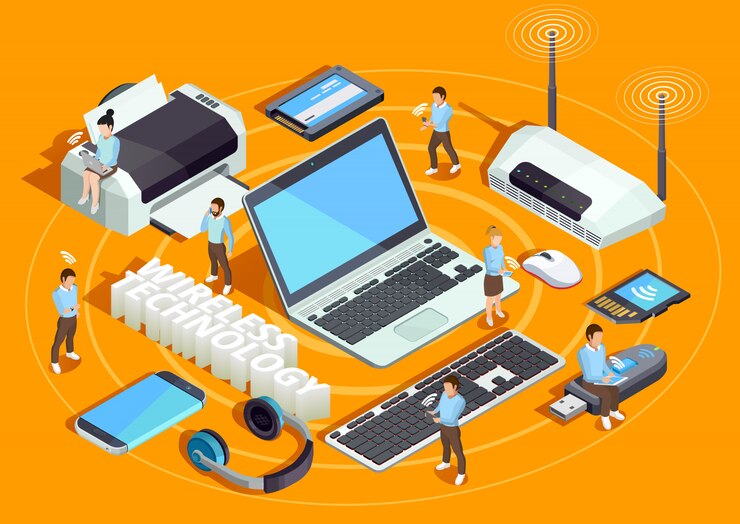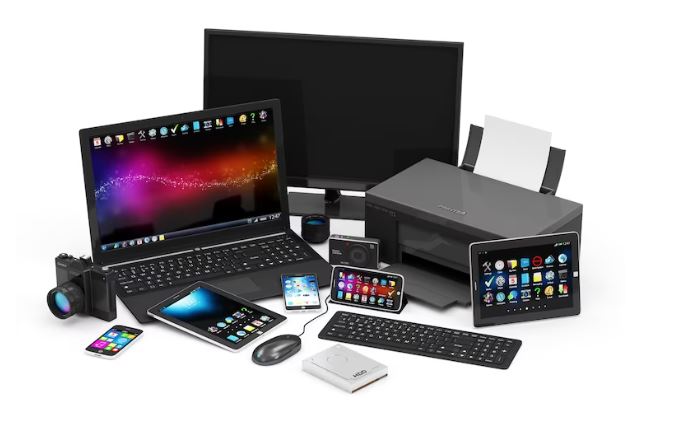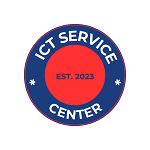The 7 ICT devices include computers, smartphones, tablets, routers, printers, scanners, and webcams. ICT, or Information and Communication Technology, devices are essential tools for communication and data processing in today’s digital age.
These devices play a crucial role in various aspects of our personal and professional lives, from accessing information to connecting with others and conducting business. With the constant evolution of technology, these ICT devices continue to improve and shape the way we interact with the digital world.
Understanding the significance of these devices is important for making informed decisions about the technology we use and how we integrate it into our daily routines. We will explore the role and importance of the 7 ICT devices in our modern society.

The Basics Of ICT Devices
Definition Of ICT Devices
ICT devices, or Information and Communication Technology devices, refer to various electronic gadgets and tools that are utilized to communicate, create, store, manage, and transmit information in a digital form. These devices encompass a broad range of technological equipment that play integral roles in today’s society, from personal use to business and industrial applications.
Importance Of ICT Devices In Modern Life
In today’s modern world, ICT devices play a crucial role in nearly every aspect of daily life. They have transformed the way people communicate, work, and manage information. From smartphones and laptops to servers and routers, ICT devices have become essential for connectivity, productivity, and the exchange of data in both personal and professional environments.
Understanding The 7 ICT Devices
What Are The 7 Ict Devices?
Evolution Of Ict Devices Over The Years
“`
The term “ICT devices” refers to Information and Communication Technology devices, which are critical components in today’s interconnected world. Understanding these devices is essential to grasp the role they play in our daily lives and the broader technological landscape.
What Are The 7 Ict Devices?
ICT devices encompass a wide range of technologies that facilitate the transmission, reception, and processing of information. The 7 fundamental ICT devices include:
1. Computers
2. Mobile Phones
3. Televisions
4. Radios
5. Tablets
6. Laptops
7. Networking devices such as routers and switches
Understanding these devices is crucial as they form the backbone of modern communication and information processing.
Evolution Of Ict Devices Over The Years
The evolution of ICT devices has been marked by rapid advancements in technology, leading to increased accessibility and functionality. Initially, these devices were bulky and limited in capabilities. However, with advancements in miniaturization and integration of various technologies, ICT devices have become more compact, powerful, and versatile.
Over the years, ICT devices have evolved to offer enhanced connectivity, computing power, and multimedia capabilities. The integration of advanced features such as touchscreens, high-resolution displays, and wireless connectivity has transformed the way we interact with these devices.
Furthermore, the convergence of multiple functionalities into a single device, such as smartphones and tablets, has revolutionized the way we communicate, access information, and entertain ourselves.
Understanding the evolution of ICT devices provides valuable insight into the technological progress that has shaped our modern society.
By delving into the nature of these devices and their historical development, we can gain a deeper appreciation for their significance in our daily lives and the broader technological landscape.
Personal ICT Devices
Personal ICT devices are gadgets designed for individual use that facilitate communication, access to information, and entertainment. These devices have become an integral part of modern lives, playing a crucial role in everyday activities.
Definition And Examples Of Personal Ict Devices
Personal ICT devices encompass a wide range of portable gadgets used for personal and professional purposes. These devices enable individuals to connect, create, and consume content on the go. Examples of personal ICT devices include:
- Smartphones
- Laptops
- Tablets
- Smartwatches
- Portable media players
Role Of Personal ICT Devices In Daily Life
Personal ICT devices play a pivotal role in modern daily life, offering convenience, connectivity, and productivity. These devices enable individuals to:
- Stay Connected: Communicate with others via calls, messaging, and social media platforms.
- Access Information: Instantly access the internet for research, news, and educational resources.
- Entertainment: Enjoy multimedia content, gaming, and streaming services for leisure and relaxation.
- Work Remotely: Complete tasks, manage schedules, and attend virtual meetings from any location.
Business ICT Devices
Business ICT devices refer to the array of information and communication technology devices used within a business setting to enhance communication, streamline processes, and improve productivity. These devices are essential for ensuring seamless operations and driving growth in today’s digital business landscape. In this section, we will delve into the definition, examples, and significance of business ICT devices.
Definition And Examples Of Business ICT Devices
In the context of business, ICT devices encompass a wide range of tools and technologies that facilitate efficient communication, data management, and workflow optimization. Examples of business ICT devices include:
- Computers and laptops for day-to-day operations
- Printers and scanners for documentation and record-keeping
- VoIP phones for cost-effective and flexible communication
- Networking equipment such as routers and switches for seamless connectivity
- Mobile devices like smartphones and tablets for on-the-go access
Importance Of Business ICT Devices For Productivity
Business ICT devices play a pivotal role in modern enterprises as they contribute significantly to enhancing productivity and efficiency. By leveraging these technologies, organizations can streamline processes, collaborate seamlessly, and access critical information swiftly. Investing in high-quality ICT devices can lead to substantial improvements in productivity, ultimately driving growth and profitability.
Communication ICT Devices
In the digital era, communication ICT devices play a pivotal role in connecting individuals across the globe. These devices use advanced technology to facilitate seamless communication and foster global connectivity.
Definition And Examples Of Communication Ict Devices
Communication ICT devices encompass a wide array of technological tools designed to facilitate real-time communication and exchange of information. These devices enable individuals to connect irrespective of geographical barriers and form the essence of modern-day communication. Examples of communication ICT devices include:
- Smartphones
- Computers and laptops
- Tablets
- Voice over Internet Protocol (VoIP) technology
- Webcams and video conferencing systems
- Social media platforms
- Instant messaging applications
Impact Of Communication Ict Devices On Global Connectivity
The advent of communication ICT devices has redefined global connectivity, bridging gaps and propelling the world towards a more interconnected future. The impact of these devices is profound, as they facilitate:
- Instantaneous communication across continents
- Cultural exchange and understanding
- Business collaborations and partnerships
- Education and knowledge dissemination
- Remote work and telecommuting
Entertainment ICT Devices
Entertainment ICT devices are technological tools and gadgets that are designed to provide users with leisure activities and enjoyment. These devices have become an integral part of modern lifestyle, offering a wide range of entertainment options for both individuals and families.
Definition And Examples Of Entertainment Ict Devices
Entertainment ICT devices encompass a variety of electronic tools and equipment that are primarily used for recreational purposes. These devices are often designed to deliver interactive and immersive content, enhancing the user experience and providing entertainment. Examples of entertainment ICT devices include:
- Gaming Consoles – such as PlayStation, Xbox, and Nintendo Switch, which offer a wide range of interactive and engaging games.
- Smart TVs – equipped with internet connectivity, allowing access to streaming services like Netflix, Hulu, and Amazon Prime Video.
- Streaming Devices – like Roku, Apple TV, and Chromecast, enabling seamless streaming of online content on television screens.
- Virtual Reality Headsets – offering immersive experiences in gaming, movies, and virtual tours.
Influence Of Entertainment ICT Devices On Leisure Activities
Entertainment ICT devices have significantly transformed leisure activities by providing easy access to a multitude of entertainment options. These devices have revolutionized the way people engage in leisure activities, influencing the following aspects:
- Convenience – Users can access entertainment content at their convenience, without being restricted by the constraints of time and location.
- Diverse Content – With a wide variety of entertainment options available, users can explore different genres and types of content to suit their preferences.
- Social Interaction – Many entertainment ICT devices support social gaming and streaming platforms, enabling users to connect and engage with friends and family members.
- Immersive Experiences – The advanced technology integrated into these devices enhances the overall entertainment experience, providing immersive and captivating content.
Future Of ICT Devices
The future of ICT devices is an exciting and rapidly evolving landscape, with continual technological advancements shaping the way we interact with technology. As we delve into the future of ICT devices, it’s crucial to recognize the significant impacts of technological advancements and make predictions for what lies ahead in the realm of ICT devices.
Technological Advancements In Ict Devices
Technological advancements in ICT devices have been pivotal in propelling the capabilities and functionalities of these devices to new heights. From the integration of Artificial Intelligence (AI) and machine learning algorithms to the implementation of 5G technology, ICT devices are becoming more efficient, intelligent, and interconnected.
Moreover, the miniaturization of components has allowed for the development of wearable and embedded devices, fostering a seamless integration of technology into our daily lives. These advancements not only enhance user experiences but also open up new possibilities for applications across various industries such as healthcare, education, and smart cities.
Predictions For The Future Of ICT Devices
Looking ahead, the future of ICT devices holds promising developments that are poised to redefine the way we engage with technology on a global scale. Innovations in augmented reality (AR) and virtual reality (VR) are expected to revolutionize entertainment, gaming, and even workforce training. Additionally, the rise of quantum computing and advancements in IoT (Internet of Things) are set to bring about a new era of hyper-connectivity and data processing capabilities.
The integration of biometrics and bionic enhancements in ICT devices is also anticipated, offering enhanced security measures and personalized user experiences. As the demand for sustainable technology grows, the future of ICT devices is likely to prioritize energy efficiency and eco-friendly designs, paving the way for a more environmentally conscious approach to technology.

Frequently Asked Questions For What Are The 7 ICT Devices?
What Are The 7 ICT Devices Commonly Used?
ICT devices generally refer to Information and Communication Technology devices. The common or primary ICT devices include computers, smartphones, tablets, routers, printers, scanners, and interactive whiteboards. These devices play a vital role in the digital era, enabling seamless communication and information processing.
How Do ICT Devices Enhance Communication?
ICT devices facilitate communication by enabling instant messaging, video calls, conference calls, and email correspondence. Additionally, they enable individuals to connect with others through social media platforms, further fostering interaction and collaboration. Ultimately, these technologies have revolutionized the way people communicate and share information in today’s digital age.
What Are The Benefits Of Utilizing ICT Devices?
The use of ICT devices offers numerous benefits, including enhanced efficiency, improved information access, and streamlined communication. Moreover, these devices empower individuals and organizations to stay connected, collaborate effectively, and access a wealth of digital resources, thereby enabling them to remain competitive in today’s constantly evolving technological landscape.
Conclusion
In the fast-paced world, staying updated with the latest ICT devices is crucial. From smartphones to wearable technology, ICT devices play a pivotal role in our daily lives. By understanding their functions and capabilities, we can harness their potential to streamline tasks, improve productivity, and enhance overall efficiency.
Exploring the diverse range of ICT devices empowers us to adapt to the ever-evolving technological landscape.

